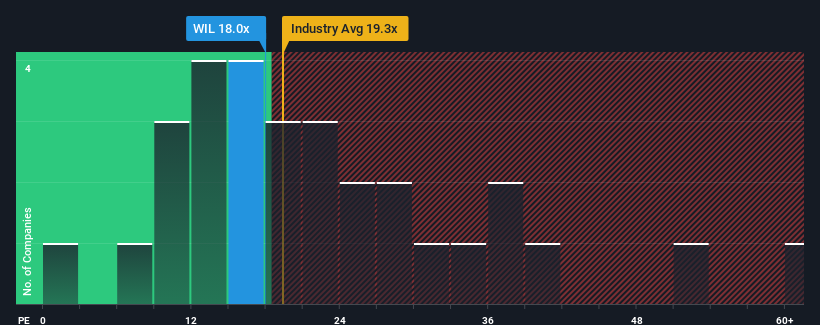- United Kingdom
- /
- Professional Services
- /
- LSE:WIL
Shareholders Should Be Pleased With Wilmington plc's (LON:WIL) Price
When close to half the companies in the United Kingdom have price-to-earnings ratios (or "P/E's") below 15x, you may consider Wilmington plc (LON:WIL) as a stock to potentially avoid with its 18x P/E ratio. However, the P/E might be high for a reason and it requires further investigation to determine if it's justified.
The recent earnings growth at Wilmington would have to be considered satisfactory if not spectacular. It might be that many expect the reasonable earnings performance to beat most other companies over the coming period, which has increased investors’ willingness to pay up for the stock. You'd really hope so, otherwise you're paying a pretty hefty price for no particular reason.
Check out our latest analysis for Wilmington

Does Growth Match The High P/E?
Wilmington's P/E ratio would be typical for a company that's expected to deliver solid growth, and importantly, perform better than the market.
Taking a look back first, we see that the company managed to grow earnings per share by a handy 3.7% last year. This was backed up an excellent period prior to see EPS up by 203% in total over the last three years. Therefore, it's fair to say the earnings growth recently has been superb for the company.
Comparing that to the market, which is only predicted to deliver 16% growth in the next 12 months, the company's momentum is stronger based on recent medium-term annualised earnings results.
With this information, we can see why Wilmington is trading at such a high P/E compared to the market. Presumably shareholders aren't keen to offload something they believe will continue to outmanoeuvre the bourse.
What We Can Learn From Wilmington's P/E?
Using the price-to-earnings ratio alone to determine if you should sell your stock isn't sensible, however it can be a practical guide to the company's future prospects.
We've established that Wilmington maintains its high P/E on the strength of its recent three-year growth being higher than the wider market forecast, as expected. At this stage investors feel the potential for a deterioration in earnings isn't great enough to justify a lower P/E ratio. Unless the recent medium-term conditions change, they will continue to provide strong support to the share price.
Before you take the next step, you should know about the 1 warning sign for Wilmington that we have uncovered.
You might be able to find a better investment than Wilmington. If you want a selection of possible candidates, check out this free list of interesting companies that trade on a low P/E (but have proven they can grow earnings).
Valuation is complex, but we're here to simplify it.
Discover if Wilmington might be undervalued or overvalued with our detailed analysis, featuring fair value estimates, potential risks, dividends, insider trades, and its financial condition.
Access Free AnalysisHave feedback on this article? Concerned about the content? Get in touch with us directly. Alternatively, email editorial-team (at) simplywallst.com.
This article by Simply Wall St is general in nature. We provide commentary based on historical data and analyst forecasts only using an unbiased methodology and our articles are not intended to be financial advice. It does not constitute a recommendation to buy or sell any stock, and does not take account of your objectives, or your financial situation. We aim to bring you long-term focused analysis driven by fundamental data. Note that our analysis may not factor in the latest price-sensitive company announcements or qualitative material. Simply Wall St has no position in any stocks mentioned.
About LSE:WIL
Wilmington
Provides data, information, training, and education solutions to professional markets in the United Kingdom, the United States, rest of Europe, and internationally.
Flawless balance sheet average dividend payer.
Similar Companies
Market Insights
Community Narratives





